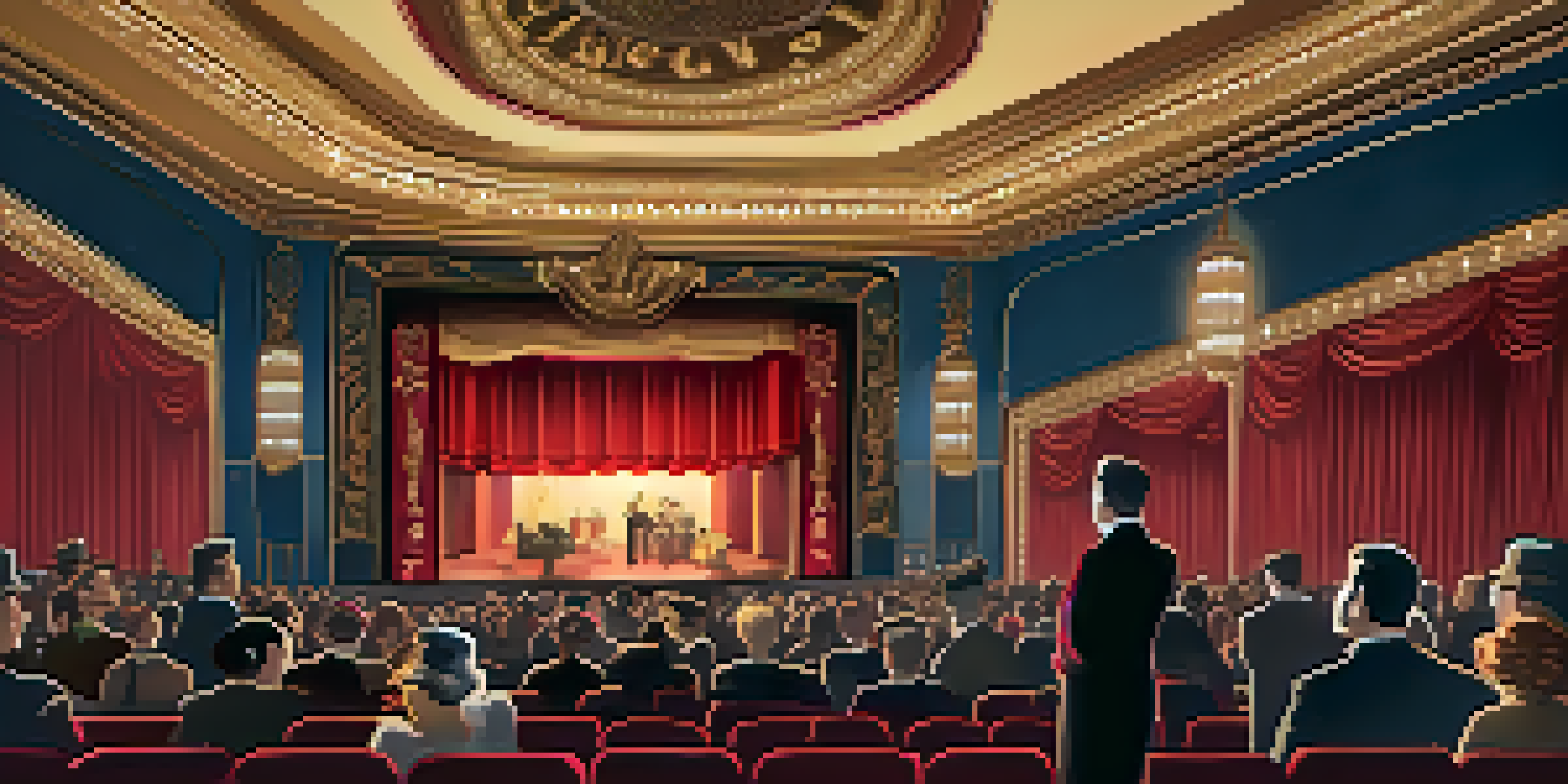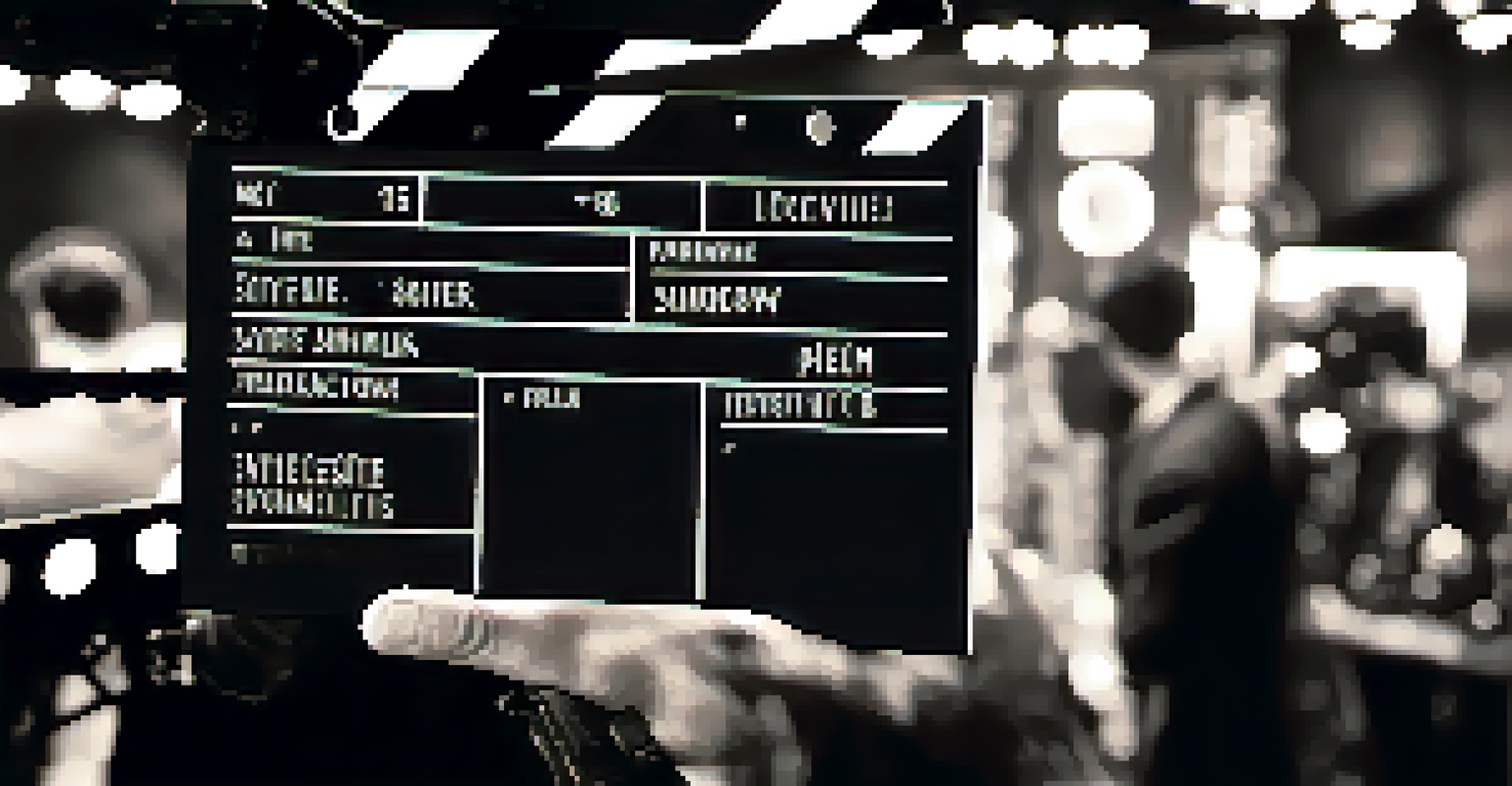The Transition Era: From Silent Films to Talkies

The Birth of Silent Films: A New Era in Entertainment
Silent films emerged in the late 19th century, captivating audiences with visual storytelling. These films relied on expressive acting, title cards, and musical accompaniment to convey emotions and narratives. Iconic figures like Charlie Chaplin and Buster Keaton became stars, using their physical comedy to transcend language barriers.
The cinema is a matter of what's in the frame and what's out.
Audiences were drawn to the simplicity and creativity of silent cinema, which allowed for a diverse range of genres, from comedy to drama. Movie theaters became social hubs where people gathered to watch and enjoy these innovative productions. The absence of sound pushed filmmakers to experiment with visual techniques, leading to a unique art form that laid the groundwork for future developments.
However, as technology advanced, the limitations of silent films became apparent. While they were groundbreaking, audiences began to crave more immersive experiences that included dialogue, sound effects, and music. This growing demand set the stage for a monumental shift in the film industry.
The Advent of Sound: A Game Changer for Cinema
The introduction of synchronized sound in the late 1920s marked a pivotal moment in film history. The first successful 'talkie,' 'The Jazz Singer,' premiered in 1927, showcasing the potential of sound in storytelling. Audiences were astonished to hear actors speak, marking a significant departure from the silent film era.

This technological breakthrough transformed the filmmaking process, as sound design became essential to storytelling. Directors now had to consider dialogue, background noise, and music, which added layers of complexity to productions. The film industry quickly adapted, leading to an explosion of creativity and innovation in the years that followed.
Silent Films Revolutionized Storytelling
Silent films utilized expressive acting and visual techniques to create a unique art form that captivated audiences.
However, the transition wasn't seamless. Many silent film stars struggled to adapt to the new medium, and some audiences were resistant to the change. Nonetheless, the excitement surrounding talkies ignited a passion for cinema that would shape its future trajectory.
Challenges Faced by Filmmakers During the Transition
The transition from silent films to talkies presented numerous challenges for filmmakers. Many studios had to invest in new technology, such as sound recording equipment, which was a significant financial burden. Additionally, filmmakers needed to rethink their approaches to storytelling, as the pacing and structure of films changed dramatically with the introduction of dialogue.
Film is one of the three universal languages, the other two are mathematics and music.
Actors who had thrived in silent films found themselves facing new hurdles, as not all of them had the vocal presence or acting style suited for talkies. For instance, some silent film stars had thick accents or voices that didn't translate well on screen, leading to their decline in popularity. This created a wave of new talent as studios sought fresh faces who could adapt to this evolving landscape.
Moreover, the necessity of sound led to a shift in film genres, with musicals and comedies gaining prominence. This evolution forced filmmakers to experiment with soundscapes and narrative techniques, ultimately enriching the cinematic experience.
The Impact of Sound on Film Genres and Styles
With the rise of talkies, genres began to evolve in exciting new ways. Musicals became a dominant force, utilizing sound to create vibrant performances that captivated audiences. Films like '42nd Street' showcased the potential of music and dance, leading to a flourishing era for this genre.
Dramatic films also saw a transformation, as dialogue added depth to character development and storytelling. The ability to hear characters’ thoughts and emotions made stories more relatable and engaging. This shift allowed filmmakers to explore complex themes and narratives that were difficult to convey in silent films.
Sound Transformed Film Production
The introduction of synchronized sound marked a pivotal shift, enhancing storytelling and expanding genres in cinema.
Furthermore, the incorporation of sound effects and ambient noise added layers of realism to films. Cinematic storytelling expanded, as sound became a vital component in crafting immersive experiences. This evolution not only changed how stories were told but also how audiences connected with the characters on screen.
Audience Reception: Embracing the New Era of Film
The audience's reception of talkies varied, with some embracing the new medium while others were hesitant. Many moviegoers were thrilled by the novelty of hearing dialogue and music, which enhanced their emotional connection to the films. The excitement was palpable, and theaters were often filled with laughter and applause as audiences reveled in this new experience.
However, not everyone was ready to let go of silent films. Some critics argued that talkies diminished the artistry of visual storytelling. They believed that dialogue could distract from the visual elements that had previously captivated audiences. Despite this resistance, the popularity of sound films continued to grow, proving that audiences were eager for change.
Ultimately, the transition era signified a broader cultural shift as society became more accepting of new technologies. The excitement surrounding sound films reflected a desire for innovation and progress, paving the way for future developments in the cinematic landscape.
The Role of Technology in the Evolution of Film
Technological advancements played a crucial role in the transition from silent films to talkies. Innovations in sound recording and projection made it possible for filmmakers to synchronize audio with moving images effectively. This technological shift not only changed the way films were made but also influenced how audiences experienced cinema.
The development of portable sound equipment allowed filmmakers to explore new locations, breaking free from the confines of studio sets. This newfound mobility enabled more dynamic storytelling and richer visual compositions. Directors could now capture the natural sounds of the environment, adding authenticity to their films and enhancing the overall experience.
Technological Advances Shaped Cinema
Innovations in sound recording and editing not only changed filmmaking practices but also enriched audience experiences.
Moreover, advancements in film editing and sound mixing techniques further refined the cinematic process. Filmmakers began to experiment with sound in creative ways, using it to build tension, create atmosphere, or evoke emotions. This technological evolution laid the groundwork for the sophisticated sound design we see in modern cinema.
Legacy of the Transition Era: Shaping Modern Cinema
The transition era from silent films to talkies left an indelible mark on the film industry, shaping the landscape of modern cinema. It paved the way for the development of various genres, including musicals, dramas, and comedies, each benefiting from the incorporation of sound. This period of innovation fostered creativity and experimentation that continues to influence filmmakers today.
Moreover, the legacy of this transition is evident in the way stories are told. The integration of sound has become a fundamental aspect of filmmaking, allowing for deeper character exploration and more compelling narratives. Today’s filmmakers build upon the groundwork laid during this era, utilizing sound to enhance their storytelling in ways that would have been unimaginable in the silent film days.

In essence, the transition from silent films to talkies represents a transformative moment in entertainment history. It not only changed how films were made and experienced but also reflected broader societal changes, paving the way for a rich and diverse cinematic landscape that continues to evolve.